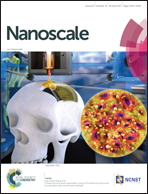Composition- and phase-controlled synthesis and applications of alloyed phase heterostructures of transition metal disulphides†
Abstract
The facile tuning of the composition and structures of two-dimensional (2D) transition metal dichalcogenide (TMD) nanosheets is essential for improving their performance in various applications, but remains difficult to realize via a direct solution process. Here, we report the one-step liquid-phase preparation of alloyed Mo1−χWχS2 nanosheets with tunable 1T/2H phase ratios. These alloyed nanosheets showed composition- and phase-dependent electrochemical and electronic properties. By tuning the Mo/W ratio, an optimized combination of high-density active sites for the hydrogen evolution reaction (HER) and low charge transfer resistance can be achieved. Additionally, due to the formation of 1T/2H (metal/semiconductor) heterojunctions, the alloyed TMD nanosheets with an optimized 1T concentration exhibited much enhanced gas sensing capability compared to the highly metallic nanosheets or the annealed semiconducting nanosheets with the same chemical composition. Our findings suggest that the ability to tune the composition and crystal structures of 2D materials via a facile one-pot solution process may provide more opportunities to control their functional properties and thus widens their range of practical applications.

- This article is part of the themed collections: Advisory Board research selection, Nanoscale 10th Anniversary: Top Authors, Celebrating Excellence in Research: 100 Women of Chemistry and 2017 Nanoscale HOT Article Collection


 Please wait while we load your content...
Please wait while we load your content...